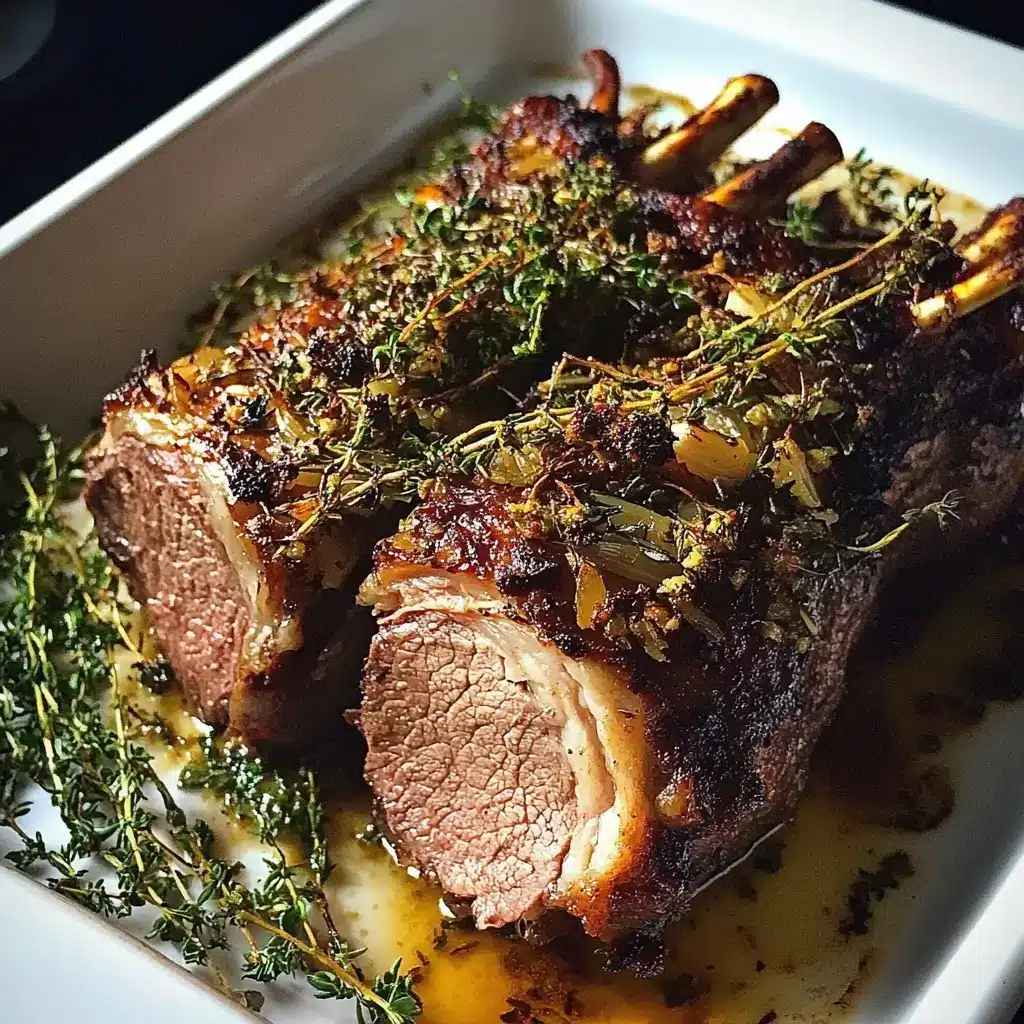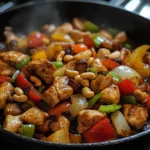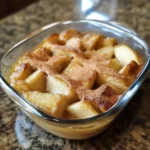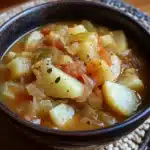Oven-roasted leg of lamb has always been a centerpiece dish in our family gatherings, a tradition passed down through generations that signifies celebration and togetherness. There’s something undeniably special about the aroma that fills the house as the lamb slowly roasts, promising a tender, flavorful meal that’s worth every minute of anticipation. This recipe, honed over years of tweaking and tasting, has become our go-to. It’s incredibly simple in its approach, relying on the natural richness of the lamb and a few key seasonings to create a truly memorable dining experience. From casual Sunday dinners to festive holiday feasts, this oven-roasted bone-in leg of lamb consistently earns rave reviews, with family members always eager for seconds (and thirds!). The crispy, herb-infused crust gives way to succulent, melt-in-your-mouth meat, making it a dish that is both impressive and comforting. If you’re looking for a show-stopping main course that’s surprisingly easy to master, look no further – this recipe is a guaranteed crowd-pleaser.
Ingredients
To create this delectable oven-roasted bone-in leg of lamb, you’ll need a selection of fresh, quality ingredients. The beauty of this recipe lies in its simplicity, allowing the natural flavors of the lamb to truly shine. Choosing high-quality ingredients will make a significant difference in the final taste and texture of your dish. Here’s a detailed breakdown of what you’ll need:
- Bone-in Leg of Lamb (5-7 pounds): The star of the show! Opt for a bone-in leg, as the bone contributes to the overall flavor and moisture of the meat during roasting. A 5-7 pound leg will comfortably serve 6-8 people, making it ideal for family dinners or small gatherings. When selecting your lamb, look for meat that is a vibrant pinkish-red color with creamy white fat marbling. This indicates freshness and quality. If possible, source lamb from a reputable butcher or farm for the best flavor and tenderness.
- Fresh Rosemary (2 tablespoons, chopped): Rosemary is a classic pairing with lamb, offering a fragrant, piney aroma and robust flavor that complements the richness of the meat beautifully. Fresh rosemary is highly recommended over dried for its brighter, more intense taste. Make sure to chop it finely to release its oils and ensure even distribution in the rub.
- Fresh Thyme (2 tablespoons, chopped): Thyme adds a subtle earthy and slightly lemony note that balances the rosemary and enhances the overall herbaceous profile of the rub. Similar to rosemary, fresh thyme is preferred for its superior flavor. Chop the thyme leaves finely, discarding any tough stems.
- Garlic (4-5 cloves, minced): Garlic is a fundamental flavor enhancer in savory dishes, and it works wonders with lamb. Minced garlic infuses the lamb with its pungent, aromatic essence, creating a savory depth that is irresistible. Use fresh garlic cloves for the best flavor, and mince them finely to maximize their surface area and flavor release.
- Olive Oil (1/4 cup): Olive oil serves multiple purposes in this recipe. It acts as a binder for the herb and garlic rub, helping it adhere to the lamb. It also contributes to browning and crisping of the skin during roasting, and adds a subtle fruity flavor. Extra virgin olive oil is a good choice for its richness and flavor, but regular olive oil will also work well.
- Lemon Juice (2 tablespoons, freshly squeezed): Lemon juice provides a bright, acidic counterpoint to the richness of the lamb and herbs. It tenderizes the meat slightly and adds a zesty freshness that elevates the overall flavor profile. Freshly squeezed lemon juice is essential for the best taste – avoid using bottled lemon juice as it lacks the same vibrancy.
- Salt (2 teaspoons, or to taste): Salt is crucial for seasoning the lamb and enhancing its natural flavors. Use kosher salt or sea salt for the best results, as they are less processed and offer a cleaner taste. Adjust the amount of salt to your personal preference, but ensure you season generously to bring out the best in the lamb.
- Black Pepper (1 teaspoon, freshly ground): Freshly ground black pepper adds a pungent, slightly spicy kick that complements the other seasonings and enhances the overall flavor complexity. Grind the pepper just before using it for the freshest and most aromatic flavor.
- Optional: Red Pepper Flakes (1/2 teaspoon, or to taste): For those who like a touch of heat, red pepper flakes can be added to the rub. They provide a subtle warmth that complements the herbs and garlic without overpowering the lamb. Adjust the amount to your spice preference.
- Optional: Dry White Wine or Chicken Broth (1 cup): Adding a liquid to the roasting pan helps to create steam, which keeps the lamb moist during cooking. Dry white wine adds depth of flavor, while chicken broth provides a more neutral option. Water can also be used if you prefer.
Instructions
Roasting a bone-in leg of lamb might seem intimidating, but this recipe breaks it down into simple, manageable steps. Following these instructions carefully will ensure a perfectly cooked, tender, and flavorful roast every time. Let’s walk through the process step-by-step:
Step 1: Prepare the Lamb
- Preheat your oven to 325°F (160°C). This lower temperature allows for slow, even roasting, which is key to achieving tender and juicy lamb. Make sure your oven is properly preheated before placing the lamb inside.
- Remove the lamb from the refrigerator at least 1 hour before cooking. This allows the lamb to come to room temperature, which promotes more even cooking. If the lamb is too cold when it goes into the oven, the outside may cook faster than the inside, resulting in uneven doneness.
- Pat the leg of lamb dry with paper towels. Removing excess moisture from the surface of the lamb is crucial for achieving a beautifully browned and crispy crust. A dry surface will allow the olive oil and herb rub to adhere better and promote Maillard reaction, the browning process that creates delicious flavors.
- Trim excess fat from the leg of lamb, if desired. While some fat is desirable for flavor and moisture, excessive fat can render out and become greasy. Trim any thick layers of fat, leaving a thin layer for flavor. You can also score the fat in a crosshatch pattern to help it render evenly and create crispy edges. Be careful not to cut into the meat.
Step 2: Make the Herb and Garlic Rub
- In a small bowl, combine the chopped fresh rosemary, chopped fresh thyme, minced garlic, olive oil, lemon juice, salt, and black pepper (and red pepper flakes, if using). This is your flavor powerhouse! Ensure all the ingredients are well combined to create a homogenous rub. The olive oil will bind the dry ingredients together and create a paste-like consistency.
- Mix all ingredients thoroughly until well combined. Use a spoon or fork to mix everything together until the herbs are evenly distributed and coated in the olive oil and lemon juice mixture. The rub should be fragrant and aromatic.
Step 3: Season the Lamb
- Place the leg of lamb in a roasting pan. Choose a roasting pan that is large enough to comfortably hold the lamb without overcrowding. A roasting pan with a rack is ideal, as it elevates the lamb and allows for better air circulation and even cooking. If you don’t have a rack, you can use chopped vegetables like onions, carrots, and celery to create a makeshift rack.
- Using your hands, generously rub the herb and garlic mixture all over the leg of lamb. Ensure you coat every surface of the lamb, including the top, bottom, and sides. Massage the rub into the meat to help it penetrate and infuse the lamb with flavor. Pay special attention to getting the rub into any crevices or scored areas.
- If using, pour dry white wine or chicken broth into the bottom of the roasting pan. Pour the liquid around the lamb, not directly over it. The liquid will create steam during roasting, which helps to keep the lamb moist and prevents it from drying out. It will also create flavorful pan drippings that can be used to make a delicious gravy or sauce.
Step 4: Roast the Lamb
- Roast in the preheated oven for approximately 20-25 minutes per pound for medium-rare, or 25-30 minutes per pound for medium. These are general guidelines, and the exact cooking time will depend on the size and thickness of your leg of lamb, as well as your oven’s accuracy. It’s crucial to use a meat thermometer to ensure the lamb is cooked to your desired doneness.
- For medium-rare, aim for an internal temperature of 130-135°F (54-57°C). For medium, aim for 135-140°F (57-60°C). For medium-well, aim for 140-145°F (60-63°C). For well-done, aim for 145-150°F (63-66°C). Insert a meat thermometer into the thickest part of the lamb, avoiding the bone. Take the temperature reading a few times during the last hour of cooking to monitor progress. Remember that the internal temperature will continue to rise slightly during resting.
- Baste the lamb with pan juices every 30-45 minutes during roasting. Basting helps to keep the lamb moist and adds flavor. Use a bulb baster or spoon to drizzle the pan juices over the lamb. If the pan juices are starting to evaporate too quickly, you can add a little more wine or broth to the pan.
- If the lamb is browning too quickly, tent it loosely with foil. If the top of the lamb is becoming too dark before the internal temperature is reached, loosely cover it with a piece of aluminum foil. This will prevent further browning while allowing the inside to continue cooking.
Step 5: Rest and Serve
- Once the lamb reaches your desired internal temperature, remove it from the oven and tent loosely with foil. Resting is a crucial step that allows the juices to redistribute throughout the meat, resulting in a more tender and flavorful roast. Tent the lamb loosely with foil to keep it warm while it rests.
- Let the lamb rest for at least 15-20 minutes before carving. During resting, the internal temperature will continue to rise slightly (carry-over cooking). Do not skip this step, as it significantly improves the texture and juiciness of the lamb.
- Carve the leg of lamb against the grain. To carve, locate the grain of the meat (the direction of the muscle fibers) and slice perpendicular to it. This will result in more tender slices. Start by slicing around the bone to remove the meat, then slice the meat into even portions.
- Serve immediately and enjoy! Serve your beautifully roasted leg of lamb while it’s still warm and juicy. Pair it with your favorite side dishes and enjoy the delicious flavors.
Nutrition Facts
(Estimated, per serving, assuming 8 servings from a 5-pound leg of lamb. Nutritional values can vary based on specific ingredients and portion sizes.)
- Servings: 8
- Calories per serving: Approximately 450-550 calories
Please Note: This is a rough estimate. The actual calorie count will depend on factors such as the fat content of the lamb, the amount of olive oil used, and the serving size. Lamb is a good source of protein, iron, and B vitamins. It also contains fat, including saturated fat, so moderation is key as part of a balanced diet. For more precise nutritional information, you can use online nutrition calculators and input the specific ingredients and quantities used in your recipe.
Preparation Time
- Prep time: 25-30 minutes (includes ingredient preparation and making the rub)
- Cook time: 1 hour 40 minutes – 2 hours 30 minutes (depending on desired doneness and size of lamb)
- Rest time: 15-20 minutes
- Total time: Approximately 2 hours 20 minutes – 3 hours 20 minutes
Note: Allow for additional time for the lamb to come to room temperature (at least 1 hour) before cooking. This is not included in the active prep time but is an important part of the overall preparation process.
How to Serve
Oven-roasted leg of lamb is a versatile dish that pairs well with a variety of accompaniments. Here are some delicious serving suggestions to create a complete and satisfying meal:
- Classic Side Dishes:
- Roasted Vegetables: Roast vegetables like potatoes, carrots, onions, Brussels sprouts, asparagus, or bell peppers alongside the lamb in the oven. Toss them with olive oil, salt, pepper, and herbs for a simple and flavorful side.
- Mashed Potatoes: Creamy mashed potatoes are a comforting and classic pairing with roasted lamb. Enhance them with garlic, herbs, or roasted garlic for extra flavor.
- Scalloped Potatoes: For a richer side dish, scalloped potatoes with cream and cheese are a decadent complement to the lamb.
- Green Beans Almondine: Crisp-tender green beans sautéed with butter and toasted almonds provide a fresh and crunchy contrast.
- Asparagus with Lemon Butter: Simple roasted or steamed asparagus drizzled with lemon butter offers a light and bright side.
- Grain-Based Sides:
- Rice Pilaf: Fluffy rice pilaf cooked with broth, herbs, and perhaps some dried fruits or nuts adds a flavorful and textural element.
- Quinoa Salad: A quinoa salad with roasted vegetables, herbs, and a lemon vinaigrette is a healthy and vibrant option.
- Couscous with Dried Fruits and Nuts: Couscous, fluffy and light, with dried fruits and nuts, provides a Middle Eastern-inspired side.
- Sauces and Gravies:
- Pan Gravy: Use the pan drippings from the roasted lamb to make a rich and flavorful gravy. Skim off excess fat, deglaze the pan with wine or broth, and thicken with a cornstarch slurry if desired.
- Mint Sauce: Classic mint sauce, made with fresh mint, vinegar, and sugar, provides a refreshing and tangy counterpoint to the richness of the lamb.
- Rosemary-Garlic Jus: Reduce the pan drippings with red wine and beef broth, adding extra rosemary and garlic for an intensely flavored jus.
- Chimichurri Sauce: A vibrant and herbaceous chimichurri sauce, made with parsley, cilantro, garlic, olive oil, vinegar, and spices, adds a South American twist.
- Salads:
- Greek Salad: A refreshing Greek salad with tomatoes, cucumbers, olives, feta cheese, and a vinaigrette provides a light and zesty contrast.
- Spinach Salad with Warm Bacon Vinaigrette: A warm spinach salad with crispy bacon and a tangy vinaigrette adds a savory and slightly sweet element.
- Arugula Salad with Parmesan and Lemon: A simple arugula salad with shaved Parmesan cheese, lemon juice, and olive oil is a peppery and bright accompaniment.
- Bread:
- Crusty Bread: Serve with crusty bread for soaking up the delicious pan juices and sauces.
- Garlic Bread: Garlic bread adds a comforting and flavorful side that complements the lamb.
- Dinner Rolls: Soft dinner rolls are always a welcome addition to any roast dinner.
Additional Tips for Perfect Oven Roasted Leg of Lamb
Achieving a perfectly roasted leg of lamb is within everyone’s reach with a few key tips and techniques. Here are five essential tips to ensure your lamb is tender, flavorful, and cooked to perfection:
- Bring the Lamb to Room Temperature: As mentioned earlier, allowing the leg of lamb to sit at room temperature for at least an hour before cooking is crucial for even roasting. This step ensures that the lamb cooks uniformly throughout, preventing the outside from overcooking while the inside remains undercooked. Think of it like giving the lamb a head start towards even temperature distribution.
- Use a Meat Thermometer (and Trust It!): The most accurate way to determine the doneness of your leg of lamb is to use a reliable meat thermometer. Forget guesswork and rely on temperature readings. Insert the thermometer into the thickest part of the lamb, being careful not to touch the bone. Monitor the temperature closely, especially during the last hour of cooking, to ensure you reach your desired level of doneness without overcooking. Different thermometers exist – instant-read thermometers offer quick readings, while leave-in thermometers allow you to monitor the temperature continuously without opening the oven.
- Don’t Skip the Resting Period: Resting the lamb after roasting is not optional – it’s an essential step for achieving maximum tenderness and juiciness. During cooking, the meat fibers contract and push juices towards the center. Resting allows these fibers to relax and reabsorb the juices, resulting in a more succulent and flavorful roast. Tent the lamb loosely with foil and let it rest for at least 15-20 minutes before carving. Resist the urge to cut into it immediately!
- Consider Marinating for Extra Flavor (Optional but Recommended): While the herb and garlic rub is incredibly flavorful on its own, marinating the leg of lamb overnight can take the flavor to another level. A marinade can penetrate deeper into the meat, adding complexity and tenderness. A simple marinade could consist of olive oil, lemon juice, garlic, herbs, red wine, and seasonings. Place the lamb in a resealable bag or container with the marinade, ensuring it’s fully coated, and refrigerate for at least 4 hours, or preferably overnight.
- Save the Pan Drippings for Gravy (Liquid Gold!): Don’t discard the pan drippings! They are liquid gold and the base for an incredibly flavorful gravy or sauce. After roasting the lamb, remove it from the pan and set aside to rest. Skim off excess fat from the pan drippings. Deglaze the pan by adding wine or broth and scraping up any browned bits from the bottom. Simmer to reduce and concentrate the flavors. You can thicken the gravy with a cornstarch slurry if desired. This homemade gravy will elevate your roasted lamb to new heights.
Frequently Asked Questions (FAQ)
Here are some common questions people have when preparing oven-roasted leg of lamb, along with helpful answers to guide you:
Q1: What is the best temperature to roast a leg of lamb?
A: Roasting leg of lamb at a lower temperature, such as 325°F (160°C), is generally recommended for achieving tender and juicy results. Lower temperatures allow for slower, more even cooking, preventing the outside from drying out before the inside is cooked through. Higher temperatures can be used for searing initially to develop a crust, but the majority of the roasting should be done at a lower temperature.
Q2: How do I know when the leg of lamb is cooked?
A: The most reliable way to determine doneness is to use a meat thermometer. Insert the thermometer into the thickest part of the lamb, avoiding the bone. Refer to the internal temperature guidelines provided in the instructions for your desired level of doneness (medium-rare, medium, etc.). Visual cues like juices running clear when pierced can be helpful, but a thermometer is the most accurate method.
Q3: Can I roast a frozen leg of lamb?
A: It is not recommended to roast a frozen leg of lamb directly. For best results, always thaw the lamb completely in the refrigerator before cooking. Roasting a frozen leg of lamb will result in uneven cooking, with the outside potentially overcooking before the inside is thawed and cooked through. Thawing ensures even cooking and better flavor.
Q4: How long should I rest the leg of lamb after roasting?
A: Allowing the leg of lamb to rest for at least 15-20 minutes after roasting is crucial. Resting allows the meat fibers to relax and reabsorb the juices, resulting in a more tender and flavorful roast. Tent the lamb loosely with foil during resting to keep it warm. Don’t be tempted to skip this step, as it significantly improves the final texture and juiciness.
Q5: What’s the best way to store leftover roasted leg of lamb?
A: Store leftover roasted leg of lamb in an airtight container in the refrigerator. It’s best to slice the lamb before storing for easier reheating and serving. Leftovers will keep for 3-4 days in the refrigerator. Reheat gently in the oven or microwave until warmed through. Leftover lamb is also delicious cold in sandwiches or salads, or can be used in recipes like shepherd’s pie or lamb curry.
Print
Oven-Roasted Bone-in Leg of lamb Recipe
Ingredients
- Bone-in Leg of Lamb (5-7 pounds): The star of the show! Opt for a bone-in leg, as the bone contributes to the overall flavor and moisture of the meat during roasting. A 5-7 pound leg will comfortably serve 6-8 people, making it ideal for family dinners or small gatherings. When selecting your lamb, look for meat that is a vibrant pinkish-red color with creamy white fat marbling. This indicates freshness and quality. If possible, source lamb from a reputable butcher or farm for the best flavor and tenderness.
- Fresh Rosemary (2 tablespoons, chopped): Rosemary is a classic pairing with lamb, offering a fragrant, piney aroma and robust flavor that complements the richness of the meat beautifully. Fresh rosemary is highly recommended over dried for its brighter, more intense taste. Make sure to chop it finely to release its oils and ensure even distribution in the rub.
- Fresh Thyme (2 tablespoons, chopped): Thyme adds a subtle earthy and slightly lemony note that balances the rosemary and enhances the overall herbaceous profile of the rub. Similar to rosemary, fresh thyme is preferred for its superior flavor. Chop the thyme leaves finely, discarding any tough stems.
- Garlic (4-5 cloves, minced): Garlic is a fundamental flavor enhancer in savory dishes, and it works wonders with lamb. Minced garlic infuses the lamb with its pungent, aromatic essence, creating a savory depth that is irresistible. Use fresh garlic cloves for the best flavor, and mince them finely to maximize their surface area and flavor release.
- Olive Oil (1/4 cup): Olive oil serves multiple purposes in this recipe. It acts as a binder for the herb and garlic rub, helping it adhere to the lamb. It also contributes to browning and crisping of the skin during roasting, and adds a subtle fruity flavor. Extra virgin olive oil is a good choice for its richness and flavor, but regular olive oil will also work well.
- Lemon Juice (2 tablespoons, freshly squeezed): Lemon juice provides a bright, acidic counterpoint to the richness of the lamb and herbs. It tenderizes the meat slightly and adds a zesty freshness that elevates the overall flavor profile. Freshly squeezed lemon juice is essential for the best taste – avoid using bottled lemon juice as it lacks the same vibrancy.
- Salt (2 teaspoons, or to taste): Salt is crucial for seasoning the lamb and enhancing its natural flavors. Use kosher salt or sea salt for the best results, as they are less processed and offer a cleaner taste. Adjust the amount of salt to your personal preference, but ensure you season generously to bring out the best in the lamb.
- Black Pepper (1 teaspoon, freshly ground): Freshly ground black pepper adds a pungent, slightly spicy kick that complements the other seasonings and enhances the overall flavor complexity. Grind the pepper just before using it for the freshest and most aromatic flavor.
- Optional: Red Pepper Flakes (1/2 teaspoon, or to taste): For those who like a touch of heat, red pepper flakes can be added to the rub. They provide a subtle warmth that complements the herbs and garlic without overpowering the lamb. Adjust the amount to your spice preference.
- Optional: Dry White Wine or Chicken Broth (1 cup): Adding a liquid to the roasting pan helps to create steam, which keeps the lamb moist during cooking. Dry white wine adds depth of flavor, while chicken broth provides a more neutral option. Water can also be used if you prefer.
Instructions
Step 1: Prepare the Lamb
- Preheat your oven to 325°F (160°C). This lower temperature allows for slow, even roasting, which is key to achieving tender and juicy lamb. Make sure your oven is properly preheated before placing the lamb inside.
- Remove the lamb from the refrigerator at least 1 hour before cooking. This allows the lamb to come to room temperature, which promotes more even cooking. If the lamb is too cold when it goes into the oven, the outside may cook faster than the inside, resulting in uneven doneness.
- Pat the leg of lamb dry with paper towels. Removing excess moisture from the surface of the lamb is crucial for achieving a beautifully browned and crispy crust. A dry surface will allow the olive oil and herb rub to adhere better and promote Maillard reaction, the browning process that creates delicious flavors.
- Trim excess fat from the leg of lamb, if desired. While some fat is desirable for flavor and moisture, excessive fat can render out and become greasy. Trim any thick layers of fat, leaving a thin layer for flavor. You can also score the fat in a crosshatch pattern to help it render evenly and create crispy edges. Be careful not to cut into the meat.
Step 2: Make the Herb and Garlic Rub
- In a small bowl, combine the chopped fresh rosemary, chopped fresh thyme, minced garlic, olive oil, lemon juice, salt, and black pepper (and red pepper flakes, if using). This is your flavor powerhouse! Ensure all the ingredients are well combined to create a homogenous rub. The olive oil will bind the dry ingredients together and create a paste-like consistency.
- Mix all ingredients thoroughly until well combined. Use a spoon or fork to mix everything together until the herbs are evenly distributed and coated in the olive oil and lemon juice mixture. The rub should be fragrant and aromatic.
Step 3: Season the Lamb
- Place the leg of lamb in a roasting pan. Choose a roasting pan that is large enough to comfortably hold the lamb without overcrowding. A roasting pan with a rack is ideal, as it elevates the lamb and allows for better air circulation and even cooking. If you don’t have a rack, you can use chopped vegetables like onions, carrots, and celery to create a makeshift rack.
- Using your hands, generously rub the herb and garlic mixture all over the leg of lamb. Ensure you coat every surface of the lamb, including the top, bottom, and sides. Massage the rub into the meat to help it penetrate and infuse the lamb with flavor. Pay special attention to getting the rub into any crevices or scored areas.
- If using, pour dry white wine or chicken broth into the bottom of the roasting pan. Pour the liquid around the lamb, not directly over it. The liquid will create steam during roasting, which helps to keep the lamb moist and prevents it from drying out. It will also create flavorful pan drippings that can be used to make a delicious gravy or sauce.
Step 4: Roast the Lamb
- Roast in the preheated oven for approximately 20-25 minutes per pound for medium-rare, or 25-30 minutes per pound for medium. These are general guidelines, and the exact cooking time will depend on the size and thickness of your leg of lamb, as well as your oven’s accuracy. It’s crucial to use a meat thermometer to ensure the lamb is cooked to your desired doneness.
- For medium-rare, aim for an internal temperature of 130-135°F (54-57°C). For medium, aim for 135-140°F (57-60°C). For medium-well, aim for 140-145°F (60-63°C). For well-done, aim for 145-150°F (63-66°C). Insert a meat thermometer into the thickest part of the lamb, avoiding the bone. Take the temperature reading a few times during the last hour of cooking to monitor progress. Remember that the internal temperature will continue to rise slightly during resting.
- Baste the lamb with pan juices every 30-45 minutes during roasting. Basting helps to keep the lamb moist and adds flavor. Use a bulb baster or spoon to drizzle the pan juices over the lamb. If the pan juices are starting to evaporate too quickly, you can add a little more wine or broth to the pan.
- If the lamb is browning too quickly, tent it loosely with foil. If the top of the lamb is becoming too dark before the internal temperature is reached, loosely cover it with a piece of aluminum foil. This will prevent further browning while allowing the inside to continue cooking.
Step 5: Rest and Serve
- Once the lamb reaches your desired internal temperature, remove it from the oven and tent loosely with foil. Resting is a crucial step that allows the juices to redistribute throughout the meat, resulting in a more tender and flavorful roast. Tent the lamb loosely with foil to keep it warm while it rests.
- Let the lamb rest for at least 15-20 minutes before carving. During resting, the internal temperature will continue to rise slightly (carry-over cooking). Do not skip this step, as it significantly improves the texture and juiciness of the lamb.
- Carve the leg of lamb against the grain. To carve, locate the grain of the meat (the direction of the muscle fibers) and slice perpendicular to it. This will result in more tender slices. Start by slicing around the bone to remove the meat, then slice the meat into even portions.
- Serve immediately and enjoy! Serve your beautifully roasted leg of lamb while it’s still warm and juicy. Pair it with your favorite side dishes and enjoy the delicious flavors.
Nutrition
- Serving Size: one normal portion
- Calories: 450-550





